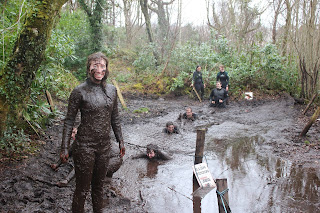Bogs are awesome. They are a wetland ecosystem, comprised of
often-acidic pH, mats of sphagnum moss, sedges and conifers, and very few
resident animals. As unique as bogs are, even more interesting is that the
combination of their characteristics contributes to an unbelievable archaeological
resource. Bogs are found the world over, and European bogs especially have been
home to amazing discoveries. I recently studied in Ireland, where bogs are
numerous and the National Museum of Ireland has an entire Archaeology Branch
filled with thousands of beautifully preserved objects, some kept safe over the
centuries in bogs… including humans.
Bogs create an anaerobic environment where bacteria that
need oxygen cannot thrive. Therefore, decomposition doesn’t occur quite so easily,
preserving anything that might fall in. However, pH levels in bogs can vary,
and due to the acidity, some bog bodies are more skeletonized than mummified.
The bog also destroys DNA, completely wiping all genetic information. Still,
the bog environment makes remarkable preservation is possible, and scientists get
a great deal of information out of bog discoveries.
The most famous Irish
bog body, called the Cashel Man, is the oldest bog body with intact skin found
anywhere in the world. He is also one of our oldest mummies, predated only by
the famous Ice Man. Believed to have died a very violent death around 2000 BC, experts
suggest that he was a king, sacrificially killed due to crop failure. Based on
Early Irish ideas of kingship, kings were tied to the land and personally
responsible for the welfare of crops and animals. They could be ceremoniously
killed if these failed. Such ritual human sacrifices were known to occur during
the Bronze and Iron Ages, especially along territorial borders or near sites
where inaugurations occurred.
 |
| Photo Credit: The Irish Examiner |
While the morbidity and drama of bog bodies intrigues many
people, they aren’t the only humans found in bogs. At an adventure camp in
Killary, Ireland, you’ll find really dirty, really cold, really happy, (and
really alive) bog bodies. An obstacle course set up in and around a few bogs allows
living humans to run, swim, and play in the mud. Andrew, one of the
instructors, will tell you in a heavy Glaswegian accent to leave valuables behind
and to even be smart about how you tie your shoes, because the bog is a living
creature that can and will swallow everything.
Jumping into the bog is startling. It’s cold and
surprisingly thick and at first, it’s easy to reel against the idea of getting
dirty. But after a few minutes, my group and I got acclimated to the cold and
we found that letting ourselves feel comfortable covered in sphagnum slop is
actually extremely fun and liberating. We joked about all the lost shoes we
found while slogging around. We panicked about how it could have been human
remains, and not tree roots that touched our legs. We mused about how much
jewelry and electronics must be down there, preserved for future generations to
discover. But the bogs helped us find a few things as well. In becoming bog
bodies, we tapped into a primal instinct, a need to converse with nature.
Everything comes full circle; nature holds the secrets of the past and helps us
to learn more about ourselves, both as individuals and as a species. It makes
me wonder what could potentially be found in the bottom of an Adirondack bog.
 |
| Army-crawling through a relatively shallow bog. Photo Credit: Killary Adventure Co. |
Sources:
-http://www.bbc.com/news/science-environment-24053119
-http://www.museum.ie/en/exhibition/kingship-and-sacrifice.aspx?article=444c508c-16a5-4208-a1c3-a687b2382e2a
No comments:
Post a Comment